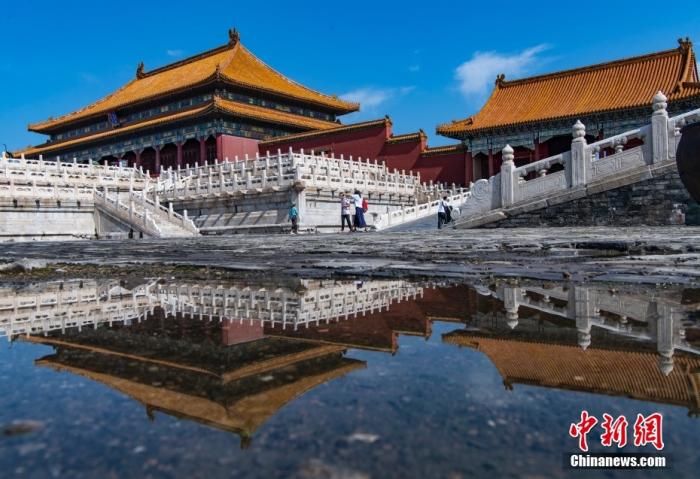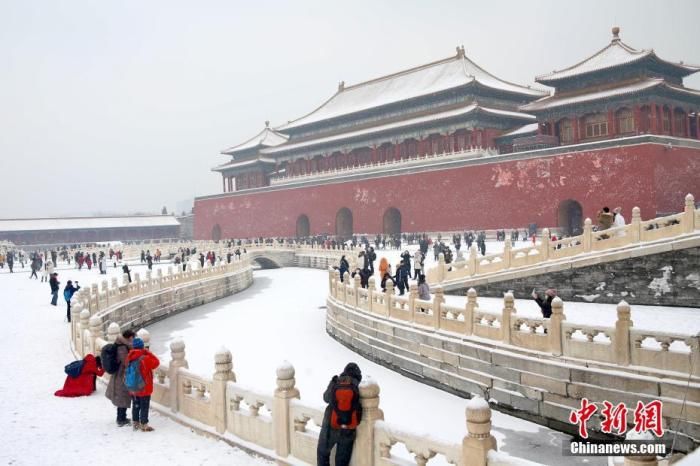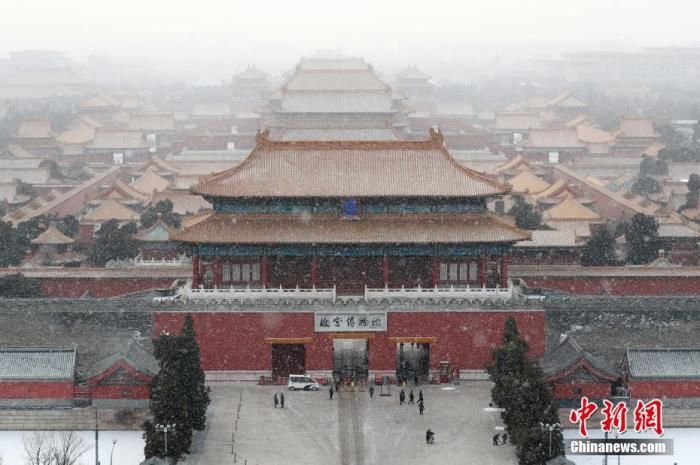Chinanews.com client, Beijing, July 24 (Reporter Shangguan Yun) One hall, one room, one utensil and one object… The Forbidden City with a long history has always attracted a lot of attention with its unique charm.
The ancient buildings of the Forbidden City belong to the traditional official wooden buildings, with strict regulations and magnificent momentum. Blue sky, yellow tiles, red walls… All year round, the beauty of the Forbidden City is full of profound historical and cultural accumulation.
 Data map: After the rain in Beijing, the Hall of Supreme Harmony and the reflection in the water form a “mirror” in the Palace Museum. Photo by China News Agency reporter Hou Yu
Data map: After the rain in Beijing, the Hall of Supreme Harmony and the reflection in the water form a “mirror” in the Palace Museum. Photo by China News Agency reporter Hou Yu
A few days ago, Jia Lixin, a poet and an associate research librarian at the Palace Museum, told an exclusive interview with a reporter from Chinanews.com. He described the architectural beauty of the Forbidden City and the beauty of the four seasons. She said that the four seasons of the Forbidden City are distinct, but she prefers autumn, which is more in line with the dignified and restrained temperament of the Forbidden City.
The architectural beauty of the Forbidden City
How rich is the cultural connotation of the Forbidden City? In “Walking to the Forbidden City slowly”, Jia Lixin (pseudonym “Hanbu”) described the origin and changes of the palace and the pavilion in the Forbidden City according to the construction regulations and the level of space.
Mentioning the architectural beauty of the Forbidden City, she said that the tradition of imitating celestial phenomena in Chinese palaces dates back to the Qin and Han dynasties. According to the ancient people’s understanding of astronomy, Ziweiyuan, Taiweiyuan, and Tianshiyuan are located in the middle of the sky, and each of the three walls has two constellations in the east and west, forming a wall.
Ziweiyuan is located in the center of Zhongtian, where the Emperor of Heaven lives. The emperor called himself “the Son of Heaven”, and the palace he lived in was naturally the Ziwei Palace. The overall layout of the Forbidden City is based on Sanyuan.
She gave an example: The inner court where the emperor lived was mainly composed of the three palaces of Qianqing, Jiaotai and Kunning, supplemented by the six palaces of east and west. number.
In addition to various majestic buildings, Jia Lixin also mentioned that turtles and cranes are symbols of longevity and prolongation, so they are generally displayed in one piece. can be seen.
 Data map: People visit the Forbidden City in the snow. Photo by China News Agency reporter Yi Haifei
Data map: People visit the Forbidden City in the snow. Photo by China News Agency reporter Yi Haifei
As for the “big tanks” that seem to be seen everywhere in the Forbidden City, they are actually made of copper, gilt copper, or iron. They are fire-fighting appliances that store water and fire.
What are the characteristics of the East and West Six Houses?
Jia Lixin introduced that in the Forbidden City, the six east and west palaces are the residences of the concubines. They are located on both sides of the three rear palaces.
“The architectural pattern of the six palaces of the east and west is very uniform. In terms of layout orientation and architectural regulations, the status of the six palaces of the east and west are all equal, and it doesn’t matter whether they are superior or inferior,” she said.
Even, even their plaques echo each other. Zhong Cui and Chu Xiu mean Zhong Ling Yuxiu, Chengqian and Yikun mean assisting the emperor, and Yonghe, Yongshou, Yanxi…meaning beauty. , and accept each other.
It is stipulated in the “Kingdom Palace”: “The queen is in the middle of the palace, and the ruler is in charge of the internal governance, one imperial concubine, two noble concubines, four concubines, and six concubines are separated from the east and west twelve palaces. Canonized nobles, always present, promised to have no position, and live in the 12th house and work diligently.”
 Data map: A group of pigeons spread their wings and fly in the square outside the Meridian Gate of the Palace Museum in Beijing. Photo by China News Agency reporter Hou Yu
Data map: A group of pigeons spread their wings and fly in the square outside the Meridian Gate of the Palace Museum in Beijing. Photo by China News Agency reporter Hou Yu
However, Jia Lixin said that the Kunning Palace, where the empresses of the Ming Dynasty lived, was on the central axis and was a veritable middle palace. Palace residence, there is no rule.
For example, Emperor Qianlong’s Empress Xiaoxian lived in Changchun Palace, and the Nala family lived in Yikun Palace. Under normal circumstances, the concubines lived in the main hall of the first palace, and the others lived in the side halls with the main seat.
Where are the beautiful flowers?
Every spring, the Forbidden City is a popular “check-in place”, and many people like to go to the Forbidden City to enjoy the flowers.
Jia Lixin described a “Flower Appreciation Guide”: to appreciate flowers in the Forbidden City, of course, go to the garden. For example, peony, peony, clove, catalpa, Taiping flower, crape myrtle, elm leaf plum in the imperial garden, magnolia, lilac, begonia, etc. in the Cining Palace Garden.
“There are not many flowers and trees in the West Sixth Palace. The most beautiful flowers and trees in the East Sixth Palace are the pear blossoms in Chengqian Palace.” She said that Chengqian Palace was famous for having lived in the concubine Dong E, who was favored by Emperor Shunzhi.
 Data map: The Palace Museum in the snow. Photo by China News Agency reporter Han Haidan
Data map: The Palace Museum in the snow. Photo by China News Agency reporter Han Haidan
Two wisterias in front of Yonghe Palace, the vines hang high, and there are purple waterfalls when the flowers bloom. Jia Lixin mentioned that the catalpa tree in front of Guhuaxuan in Qianlong Garden is also very beautiful. The pale pink and purple flowers are delicate and delicate, which contrast with the tall and rough tree.
“This ancient tree was more than 100 years old when Guhuaxuan was built in the thirty-seventh year of Qianlong’s reign, and it is now nearly 400 years old. It usually blooms in late April, and the flowering period is very short, only more than 10 days. ‘ she said.
The four seasons of the Forbidden City are distinct. However, Jia Lixin prefers autumn because it is more in line with the dignified and restrained temperament of the Forbidden City.
“At this time, the splendor of summer is not far away, and the autumn leaves have also changed into new clothes, either delicate yellow or red, and the fruits are already ripe and full. It’s extraordinarily quiet and far away,” she said. (End)